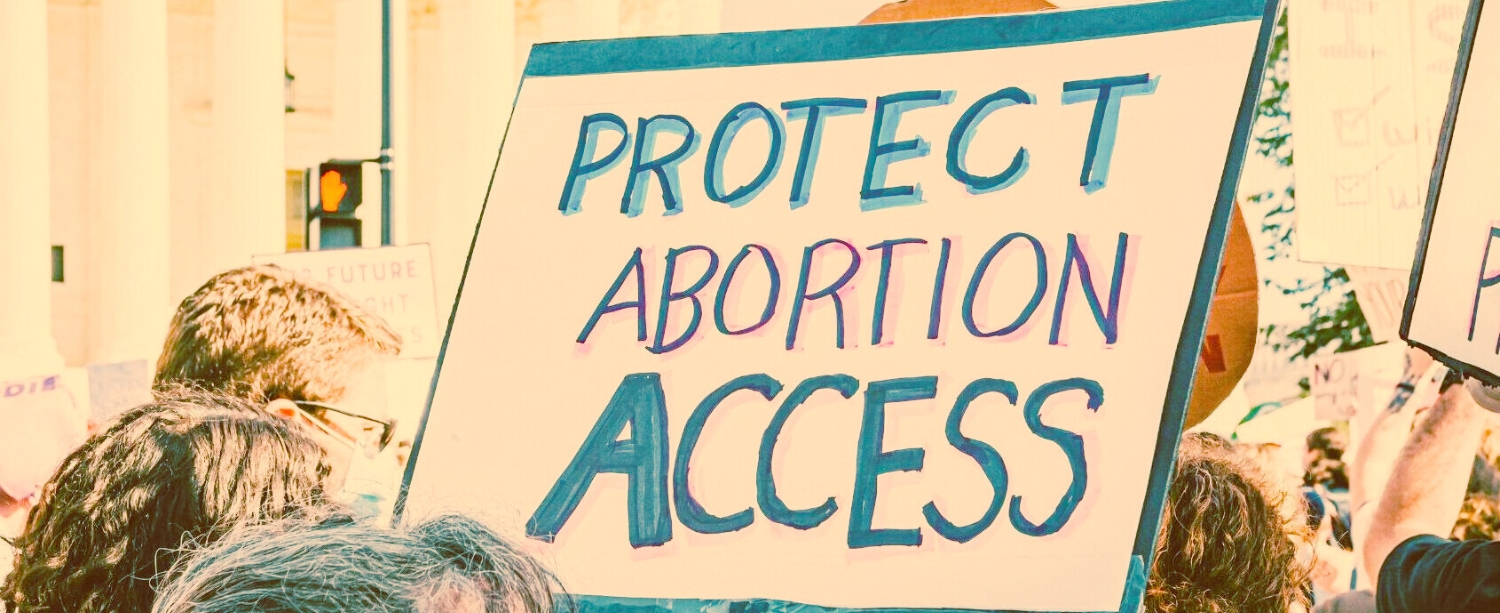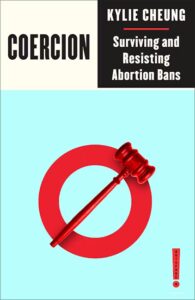
The Value of Women’s Lives: How Abortion Bans Escalate Domestic Violence
Kylie Cheung Explores the Life-Threatening Risks of Seeking an Abortion After the Overturn of Roe v. Wade
In May 2023, a Texas man shot and killed his girlfriend after she returned from traveling to Colorado to get an abortion, because abortion is banned in Texas. Police reports showed that the man had strangled and assaulted her just days before killing her, and he acknowledged that he knew she was pregnant. He’d previously punched her in the face, giving her a black eye and bruises on her body.
According to Everytown for Gun Safety, 70 women every month are shot and killed by an intimate partner. It’s not a coincidence that around the same time the Supreme Court decided Dobbs, the court also moved to lift restrictions on buying firearms, expanding access to guns for potential abusers. State violence compounds by design; abuse victims suffer the consequences.
The homicide in Texas in 2023 is one of too many such stories of pregnancy escalating domestic violence, ending in tragic fatality. In 2024, Molly Voyles, director of public policy at the Texas Council on Family Violence, told me the victim services organization’s tracking showed 72 women were killed by their intimate partners when they were pregnant or within one year postpartum between 2017 and 2023. “Banning abortion care for survivors of intimate partner violence is anything but accommodating to survivor-centered services, threatening the safety of thousands of survivors as they try to restore safety, privacy and autonomy to their lives,” Voyles said.
It’s possible the young woman’s partner would have killed her had abortion been legal in Texas, and she’d been able to obtain it in the state. It’s also possible the added necessity of leaving the state for care made the abortion more difficult to conceal, worsening her vulnerability to violence, producing a deadly outcome. This is another material impact of abortion bans: extreme, unbearable physical violence; for some, particularly for domestic violence victims, the loss of life itself.
Abortion bans force people in potentially unsafe situations to remain pregnant against their will, sometimes at serious risk to their lives.
When the Texas man, Harold Thompson, killed his girlfriend Gabriela Gonzalez for traveling out of state to have an abortion in the spring of 2023, the horrific act of intimate partner violence came nearly one year after a similar development: In the summer of 2022, a Missouri man was sentenced to life in prison for murdering his wife a few years earlier. Just before she went missing, his wife had searched: “what to do if your husband is upset you are pregnant.”
Homicide, mostly by an intimate partner, is the leading cause of death for pregnant people in the U.S. Abusive situations are likely to escalate when someone becomes pregnant. Abortion bans force people in potentially unsafe situations to remain pregnant against their will, sometimes at serious risk to their lives—again, several states with abortion bans even prohibit divorce from being finalized while someone is pregnant.
In 2022, Rachael Lorenzo, director of the reproductive justice fund Indigenous Women Rising, recounted trying to support a Spanish-speaking caller who sought an abortion to flee a “violent situation,” and had several young children. The woman asked only that IWR mail her an envelope of cash to help her travel to Michigan for the procedure, and not call her cell phone unless she first sent a text message. Lorenzo sent the envelope of cash, but within days, it was mailed back to IWR, and they never heard from the woman again. “It is such a sacred thing for someone to be so vulnerable with us, and to let us in on what’s happening in their lives when they might be in danger,” Lorenzo told me.
“For some people, you’re basically risking your life to try to make an appointment.”
Emma, an organizer at the Roe Fund in Oklahoma, told me her callers are sometimes abuse victims completely under their abusers’ control and surveillance. Her state has the highest domestic violence rate in the nation. “It makes it even harder, on top of the ban, when you don’t have control over your money, or have a car, or your schedule or location or your mail are being watched, cell phone is being watched—that makes it nearly impossible,” Emma said. Domestic violence advocacy workers sometimes connect their clients to Roe Fund, but Emma says she worries that many victims who would otherwise seek abortion care may be too afraid of legal risk or being reported to ask their advocates for help, which means the victims who are referred to her are just a fraction of those who might need abortions. Many don’t even know help is available to them at all.
Emma takes all privacy and security precautions possible when communicating with callers, but still constantly struggles with the fear that “I’m making a woman even more endangered—is this phone call or text to them going to create even more problems?” She continued, “I don’t think people realize how precarious this all is. For some people, you’re basically risking your life to try to make an appointment.”
Recall that, about two years after Dobbs, a new study showed a direct link between anti-abortion TRAP laws and higher rates of intimate partner violence-related homicide, even as anti-abortion lawmakers ironically justified TRAP laws as a necessity for “women’s safety.” Between 2014 and 2020, that study estimated 24 women and girls of reproductive age were victims of an intimate partner violence-related homicide associated with TRAP laws.
“Survivors are being trapped by these abortion laws,” Marrium Durrani, vice president of policy at the National Domestic Violence Hotline, told me in 2024 when the study was published. “In this really terrible new landscape, it’s only going to . . . cause more death, more violence targeting people who are in abusive relationships.” She also raised previous research put forth in the landmark Turnaway Study, a groundbreaking, longitudinal research project by University of California, San Francisco researchers assessing the enduring impacts of being denied wanted abortion care. The study showed that people who are denied abortion are at a significantly greater risk of long-term domestic violence. “You might find people tied to their abusers for much longer if they have children with them, creating heightened, longer-term danger,” Durrani said.
Rita Smith, vice president of external relations at the direct services organization Domestic Shelters, told me that it will take years to begin to comprehend the full extent of gendered violence and death inflicted by abortion bans since Dobbs: “Criminal justice data is often lagging, so we may not fully see the impact of these laws on domestic violence victims for years, but I would be surprised if we don’t see an increase in the number of domestic violence homicides during this time, in abortion-restrictive states.” Between confusion about when hospitals can act to save pregnant people’s lives and, as the May 2024 study shows, greater exposure to intimate partner violence homicide in connection with abortion restrictions, Smith argued that we’re in the middle of a reckoning: “We’re seeing a cultural shift in what the value of women’s lives is.”
*
When lawmakers ban the health service that’s a lifeline for domestic violence victims, a lifeline for people experiencing severe pregnancy complications, a lifeline for people who don’t consent to being pregnant, this has the same impact and toll as violent men and abusive partners physically attacking their pregnant victims. Abortion bans are gender-based violence. By the end of 2024, ProPublica reported the confirmed deaths of five women—three in Texas and two in Georgia—that resulted from their states’ respective abortion bans.
In Georgia, shortly after the state’s ban took effect in 2022, Amber Nicole Thurman and Candi Miller, two Black mothers, died after experiencing complications with medication abortions and being unable to receive a simple emergency abortion procedure in a timely manner. One hospital waited 20 hours to give Thurman an emergency abortion, at which point, she’d contracted sepsis and died during the procedure. Miller, meanwhile, was too afraid to go to the hospital as she experienced complications from a medication abortion, because she feared she could go to prison under Georgia’s abortion law, even though the law only explicitly criminalizes abortion providers. Miller, too, developed sepsis and died.
Each of these women’s lives contained whole universes; they had futures, they had children or other loved ones, and they deserved so much more.
In Texas, Honduran immigrant Josseli Barnica died of sepsis because doctors waited 40 hours for her fetus’ heartbeat to stop before providing an emergency abortion to safely complete her miscarriage. Her death came just days after S.B. 8, the state’s “bounty hunter” abortion ban, took effect in 2021. Around the same time, three Texas hospitals turned away 18-year-old Nevaeh Crain as she suffered from pregnancy complications; she died from sepsis within hours of arriving at the third hospital. And in 2023, Porsha Ngumezi, a mother of two young sons, also died when her condition rapidly deteriorated, and the hospital declined to perform an emergency abortion to stop her hemorrhaging as she miscarried. “We all know pregnancies can come out beautifully or horribly,” Ngumezi’s husband, Hope, told ProPublica. “Instead of putting laws in place to make pregnancies safer, we created laws that put them back in danger.”
Each of these women’s lives contained whole universes; they had futures, they had children or other loved ones, and they deserved so much more. Abortion bans unjustly took them from us.
In 2024, the Gender Equity Policy Institute reported that maternal deaths in Texas increased by 56% between 2019 and 2022, compared to an 11% increase nationwide during the same time period. “There’s only one explanation for this staggering difference in maternal mortality. All the research points to Texas’ abortion ban [S.B. 8, which took effect in September 2021] as the primary driver of this alarming increase,” the organization’s president said. And, again, abortion bans also increase the risk of suicide, per a 2022 study from the University of Pennsylvania—this is another threat to pregnant people’s lives. In 2022, Ohio doctors filed an affidavit challenging the state’s then-active abortion ban; they referenced the stories of three women in the state who had recently threatened suicide over being denied abortions. This, of course, is an entirely understandable reaction: Pregnancy, birth, and parenthood can change lives and, if imposed on someone by the state as a punishment, can rob people of their futures.
Prior to Dobbs, maternal mortality rates had been steadily increasing for years. By 2017, the maternal mortality rate for young millennial women had more than doubled since the baby-boomer generation. A report put forth by the Center for Reproductive Rights that same year showed states with more restrictions on abortion had higher maternal mortality rates. In 2015, South Carolina’s maternal mortality rate spiked by nearly 300%, amid the fallout of increasing restrictions on abortion access. That same year, a third of women in the state reported having no dedicated health care provider. Communities of color suffer from significantly higher maternal mortality than white communities—Black pregnant people are three to four times more likely to die from pregnancy and birth-related causes, in no small part due to medical racism and racialized barriers to access health care. A report published by National Partnership for Women & Families in May 2024 showed 57% of Black women and pregnant-capable people ages 15 to 49 live in states with bans or significant threats to abortion access.
As journalist Susan Rinkunas wrote in 2022, pregnancy is an innate “risk to the lives of women and pregnant people”:
Untreated miscarriages, dangerous deliveries, and other pregnancy-related health problems contribute to a shockingly high maternal mortality rate in the U.S. This mortality rate doesn’t even take into account homicide: Pregnant women are more likely to be killed, often at the hands of an intimate partner, than they are to die of health problems in America.
The U.S. maternal mortality rate, as presented to us via state and federal data, is inevitably undercounted. Homicide presents a grave risk to pregnant people—perhaps even more so than health-related complications—but homicides aren’t even tracked among pregnancy-related deaths in the U.S.
Suppression of tracking maternal mortality presents a crisis of its own post-Dobbs, as the state attempts to not just inflict gendered violence via abortion bans but also to conceal it. In 2024, shortly after ProPublica published reports on Miller and Thurman’s abortion ban-induced deaths by consulting with anonymous members of Georgia’s maternal mortality committee, the state disbanded the entire committee in retaliation for sharing data with the media. Around the same time, leaders of Texas’ maternal mortality committee, appointed by the zealously anti-abortion administration of Governor Greg Abbott, announced they wouldn’t analyze maternal mortality data from 2022 to 2023—the first years after the state’s sweeping abortion ban took effect.
Pregnancy endangers victims in abusive relationships, and the threat of health complications during pregnancy endangers their lives, too.
In 2023, Idaho unceremoniously ended its maternal mortality review committee, before bowing to public pressure and passing a bill to reinstate it the following year. This came around the same time that the state’s criminal abortion ban—which offers only an ambiguous exception to save the pregnant person’s life, whatever that means, and otherwise threatens doctors with prison—began driving OB-GYNs maternal care providers out of the state in droves. In March 2023, a hospital in a rural region of Idaho was forced to shutter its entire labor and delivery department after an exodus of OB-GYNs who feared that continuing to do their jobs in the state could land them in prison. (Since, several more hospitals in the state have shuttered their maternal care departments.)
Just months earlier, in December 2022, Idaho resident Carmen Broesder documented her 19-day miscarriage in a series of gut-wrenching videos, expressing fear that she would die before anyone helped her due to the state’s abortion ban. Despite the excruciating pain and severe blood loss she experienced, Broesder was denied the emergency abortion procedure that would have safely ended her miscarriage and averted further health complications. She told me in the spring of 2023 that she sought the procedure from OB-GYNs in her state twice but was turned away. “A doctor told me ‘don’t come back until your pain or bleeding is worse,’ like I’m dying,” Broesder said. She went to another hospital where she says a doctor “looked at me with pity but said ‘there’s confusion, trepidation regarding the abortion law,’” and he couldn’t act yet. Kimra Luna, the co-founder of the organization Idaho Abortion Rights Collective (IARC), told me in March 2023 that Broesder’s story was among the most publicly visible, but IARC had heard from and supported numerous callers with similar experiences.
In addition to suppression of maternal mortality and morbidity tracking, since the overturn of Roe, anti-abortion state governments have also appointed bad actors to these tracking committees, as we saw in Texas in 2024. For years, Texas has suffered from one of the worst maternal mortality rates in the nation, which only worsened after the state’s abortion ban took effect. In May 2024, the state health department then announced one of the 23-member maternal mortality committee’s seven new appointees: Dr. Ingrid Skop, a rabidly anti-abortion OB-GYN who testified before Congress in 2021 that child rape victims as young as nine and ten years old could safely carry pregnancies and give birth.
Skop’s testimony came as part of her arguments for why abortion bans shouldn’t include rape exceptions, and ignored how pregnancy at such a young age comes with significant health risks and a substantially greater risk of mortality—all on top of the obvious long-term trauma of being a pregnant, child rape victim. “If she is developed enough to be menstruating and become pregnant and reach sexual maturity, she can safely give birth to a baby,” Skop said in 2021. Shortly after Skop was introduced as a new member of the state’s maternal mortality committee, she wrote in the Houston Chronicle: “For over 30 years, I have advocated for both of my patients, a pregnant woman and her unborn child.”
In the summer of 2023, Reverend Dr. Love Holt, an organizer with Abortion Action Missouri and an abortion doula, told Congress that she nearly died earlier that year due to a delay in getting medical help during complications from a medication abortion. Upon learning she was pregnant, she ordered abortion pills, but the first set was stolen, and the replacement pills she ordered didn’t arrive until days later. By the time she received the medication, she was past 13 weeks pregnant; abortion pills are most effective before 13 weeks, she noted, but she decided to take the medication anyway. Within minutes, she said, she began intensely bleeding, cramping, and becoming lightheaded, eventually going to her car so she wouldn’t “traumatize my children from the sight of seeing me constantly spilling blood.” Her children found her in her car unresponsive; she was “rushed off to the ER for severe blood loss,” and “nodded in and out of consciousness for several minutes.” Holt recounted being taken to the ER of a Catholic hospital and said that “instead of thinking about survival, I thought about not going to jail.” She continued, “I told myself, ‘Make sure you tell staff that you’re having a miscarriage,’ but I knew I was having an abortion.”
Medication abortion is highly safe, and rarely results in complications.5 But, as with any medication, if complications arise, people should feel safe immediately seeking medical help. Holt told me in July 2023 that her experience was “a glimpse at the future for hundreds of thousands of people” who will be forced to fear the legal ramifications of getting help to end a pregnancy. “Forcing people to carry unwanted pregnancies drives people into further positions of poverty,” she continued. “Poverty gives birth to violence and survival modes that make people unpredictable. They do things that they would normally not do.”
A year prior to Holt’s remarks before Congress, and just one month before Dobbs, she’d shared her story in an op-ed: “Back in 2014, I never would have guessed that one day I would be living in an America that disapproves of my choice to a medical abortion after conceiving amidst an abusive marriage,” Holt wrote. She continued:
I decided to leave my abuser after giving birth to my fourth child while enduring physical and emotional abuse, but he knew that five children would restrict my ability to leave. The decision to leave was tough, but I knew that if I could survive this abuse, I would have an opportunity to raise my current children free from violence . . . I share my story to emphasize the importance of Roe v. Wade and the impacts the anticipated Supreme Court decision will have on those most at risk: Black people, people of color, people surviving economic insecurity, trans people, immigrants, youth, people with disabilities and especially those who have been subjected to abuse.
Holt further noted that her state, Missouri, suffered from the third highest rate of domestic violence in the U.S., and that “Black women experience domestic violence at a higher rate than many other groups and are two-and-a-half times more likely to die at the hands of their abusers.”
Holt’s abortion experiences reflect the reality of dual violence that pregnant people can experience, all exacerbated by abortion bans. Pregnancy endangers victims in abusive relationships, and the threat of health complications during pregnancy endangers their lives, too.
*
In Oklahoma, which banned abortion after Dobbs and has the highest rate of domestic violence in the nation, advocates working in victim services warned that the state’s new abortion laws have put victims at greater risk. A forensic nurse administrator at the Tulsa Police Department told Mother Jones in 2024 that they’ve seen some abusers “just keep the patient pregnant so they can’t leave.” Durrani told me that, among a range of horrific experiences with reproductive coercion that have been reported to the Hotline, one caller said their partner didn’t allow her to use contraception, and then threatened to kill her after she became pregnant; another caller became pregnant in a state that banned abortion after her partner sexually assaulted her. Again, in 2023, the Hotline revealed that calls involving acts of reproductive coercion doubled between the summer before Dobbs and the summer after.
At the same time the Supreme Court issued the Dobbs ruling, it also issued the ruling New York State Rifle and Pistol Association v. Bruen, which recognized a constitutional right to carry a handgun in public for self-defense and struck down a New York state restriction on firearms, consequently making them more accessible. The dual timing of these decisions to limit abortion access and potentially expand firearm access to abusers had compounding impacts for pregnant domestic violence victims.
In May 2023, Harold Thompson used a gun to kill his girlfriend Gabriela Gonzalez for having an abortion; he held that gun despite police reports documenting his history of violence toward Gonzalez. Between 2018 and 2022, the number of women who have been shot and killed by an abuser nearly doubled in the state of Texas, which both bans abortion and suffers from endemic gun violence.
______________________________

Excerpted from Coercion: Surviving and Resisting Abortion Bans by Kylie Cheung. Copyright © 2025. Available from Pluto Press.
Kylie Cheung
Kylie Cheung is a reporter at Abortion, Everyday where she reports on reproductive rights and gender-based violence, and a former staff writer at Jezebel. She is the author of Survivor Injustice: State-Sanctioned Abuse, Domestic Violence, and the Fight for Bodily Autonomy. Her work has been published in Salon, Teen Vogue, Guardian and Ms. Magazine. She lives in Brooklyn.












